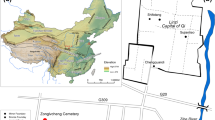Abstract
Iulia Concordia is an important Roman settlement especially known for the production of weapons during the Roman Empire. Excavations of the area revealed the evidence of metal-working activities and a huge number of well preserved arrowheads (sagittae) were found. In order to investigate the conservation state of the finds and to shed light about the production processes used by Roman for the manufacturing of sagittae, a neutron tomography analysis was performed on NEUTRA beam line at the Paul Scherrer Institut in Switzerland. Here, we present results from our investigation conducted on 18 samples, disclosing, in a non-invasive way, the morphological characteristic related to the ancient Roman working techniques.





Similar content being viewed by others
References
E. Di Filippo Balestrazzi, A. Vigoni, Punte di freccia dall’area del teatro Romano di Iulia Concordia. (Aquileia Nostra LXXX, 2009), pp. 43–60
P.L. Zovatto, Portogruaro, Museo Nazionale Concordiese. Concordia: scavi, battistero. Summaga: abbazia. Sesto al Reghena: abbazia. Caorle, in Musei d’Italia, meraviglie d’Italia, III (Calderini, Bologna, 1971)
G. Brusin, P.L. Zovatto, Monumenti romani e cristiani di Iulia Concordia (Il Noncello, Pordenone, 1960)
A. Vigoni, Il canale interno di Iulia Concordia. Dati storici, archeologici e topografici, in Tra Oriente e Occidente, ed. by D. Morandi Bonacossi, E. Rova, F. Veronese, P. Zanovello (Padova, 2006), pp. 51–68
J.C.N. Coulston, Roman archery equipment, in The Production and Distribution of Roman Military Equipment: proceedings of the second Roman military equipment: proceedings of the second Roman military equipment (Oxford, 198), pp. 220–337
M.C. Bishop, J.C.N. Coulston, Roman Military Equipment, 2nd edn. (Oxbow Books, Oxford, 2006)
E. Lehmann, S. Hartmann, Archaeometry 52(3), 416–428 (2010)
F. Salvemini et al., J. Anal. At. Spectrom. 27, 1494 (2012)
F. Salvemini et al., Archaeol. Anthropol. Sci. 5, 197–204 (2013)
F. Grazzi et al., Mater. Sci. Forum 652(4), 167–173 (2010)
F. Grazzi et al., Anal. Bioanal. Chem. 395, 1961 (2009)
F. Grazzi et al., Anal. Bioanal. Chem. 400, 1493 (2011)
F. Grazzi et al., J. Anal. At. Spectrom. 26, 1030 (2011)
F. Grazzi et al., J. Anal. At. Spectrom. 27, 179–186 (2012)
G. Festa et al., Meas. Sci. Technol. 24, 125903 (2013)
A.C. Kak, M. Slaney, Principle of Computerized Tomographic Imaging (IEEE Press, Piscataway, 1987)
F. Natterer, The Mathematics of Computerized Tomography (Classics in Applied Mathematics, 32), (Society for Industrial and Applied Mathematics, Phyladelphya, 2001)
M. Dierick, B. Masschaele, L. Van Hoorebeke, Meas. Sci. Technol. 15(7), 1366–1370 (2004)
E. Lehmann, P. Vontobel, L. Wiezel, Nondestr. Test Eval. 16, 191–202 (2001)
A.R. Williams, The Knight and the Blast Furnace: A History of the Metallurgy of Armour in the Middle Ages and the Early Modern Period (Brill Academic Pub, Leiden, 2003)
F. Salvemini, F. Grazzi, I. Angelini, P. Vontobel, A. Vigoni, G. Artioli, M. Zoppi, Morphological reconstruction of Roman styli from Iulia Concordia, submitted to Archaeometry
Author information
Authors and Affiliations
Corresponding author
Appendix
Appendix
Hereafter, we reported cross sections taken from the 3D reconstruction of the investigated arrowheads, which were not shown in the main section of the paper. The data are arranged according to the three different categories of samples: triangular, flat and quadrangular.
Each sample is virtually cut along three orthogonal directions: the upper image is always referred to the axial section, whose position is defined by the horizontal red line crossing the normal and transversal views, placed side by side on the bottom. The normal and transversal slices are acquired at the centre of the axial one. At the top of each slice-group, the sample reference number is reported.
1.1 Triangular arrowheads
1.2 Flat arrowheads
See Fig. 9.
1.3 Quadrangular arrowheads
Rights and permissions
About this article
Cite this article
Salvemini, F., Grazzi, F., Angelini, I. et al. Morphological reconstruction of Roman arrowheads from Iulia Concordia: Italy. Appl. Phys. A 117, 1227–1240 (2014). https://doi.org/10.1007/s00339-014-8511-3
Received:
Accepted:
Published:
Issue Date:
DOI: https://doi.org/10.1007/s00339-014-8511-3










